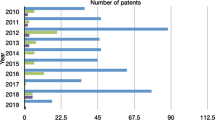Abstract
The dissolution behaviour of model alkali-soluble polymer emulsions with different molecular weights was studied using conductometric and potentiometric titration and laser light scattering techniques. The behaviour of the copolymer was studied as a function of the degree of neutralisation, α = [NaOH]/[COOH]. The polymer latex swells with increasing α values up to α = 0.5–0.7, after which the dissociation of polymer chains commences. At α = 1.0, all the polymer latexes dissociate into individual polymer chains. By combining the results of static and dynamic laser light scattering, we observed that the polymers have a compact conformation at α = 0. This compact conformation changes to a random coil at around α = 0.5, which then becomes a fully extended coiled conformation at α = 1.0, when all the COOH polymer groups are hydrolysed. The dissolution of low-molecular-weight polymers is faster than that of high-molecular-weight polymers.
Similar content being viewed by others
Author information
Authors and Affiliations
Additional information
Received: 15 February 1999 Accepted in revised form: 13 July 1999
Rights and permissions
About this article
Cite this article
Siddiq, M., Tam, K. & Jenkins, R. Dissolution behaviour of model alkali-soluble emulsion polymers: effects of molecular weights and ionic strength. Colloid Polym Sci 277, 1172–1178 (1999). https://doi.org/10.1007/s003960050506
Issue Date:
DOI: https://doi.org/10.1007/s003960050506




